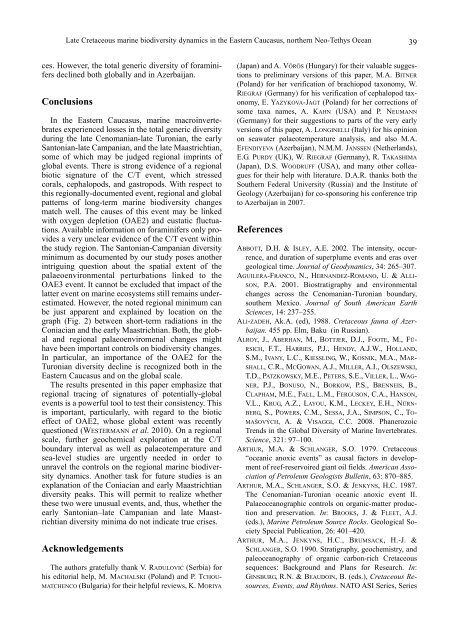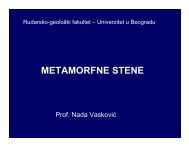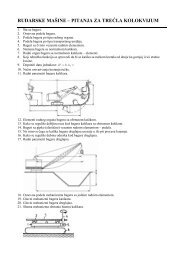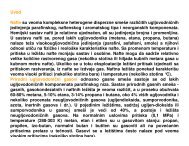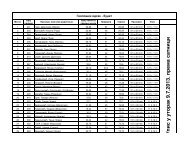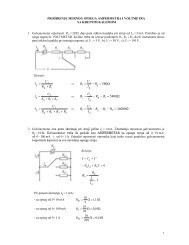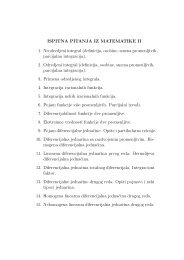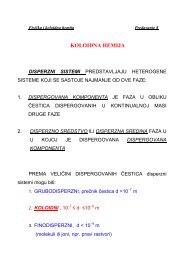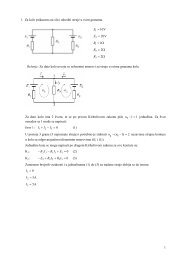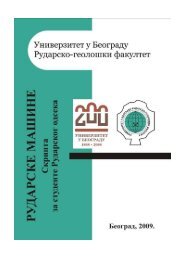KÑига LXXII
KÑига LXXII
KÑига LXXII
You also want an ePaper? Increase the reach of your titles
YUMPU automatically turns print PDFs into web optimized ePapers that Google loves.
Late Cretaceous marine biodiversity dynamics in the Eastern Caucasus, northern Neo-Tethys Ocean 39<br />
ces. However, the total generic diversity of foraminifers<br />
declined both globally and in Azerbaijan.<br />
Conclusions<br />
In the Eastern Caucasus, marine macroinvertebrates<br />
experienced losses in the total generic diversity<br />
during the late Cenomanian-late Turonian, the early<br />
Santonian-late Campanian, and the late Maastrichtian,<br />
some of which may be judged regional imprints of<br />
global events. There is strong evidence of a regional<br />
biotic signature of the C/T event, which stressed<br />
corals, cephalopods, and gastropods. With respect to<br />
this regionally-documented event, regional and global<br />
patterns of long-term marine biodiversity changes<br />
match well. The causes of this event may be linked<br />
with oxygen depletion (OAE2) and eustatic fluctuations.<br />
Available information on foraminifers only provides<br />
a very unclear evidence of the C/T event within<br />
the study region. The Santonian-Campanian diversity<br />
minimum as documented by our study poses another<br />
intriguing question about the spatial extent of the<br />
palaeoenvironmental perturbations linked to the<br />
OAE3 event. It cannot be excluded that impact of the<br />
latter event on marine ecosystems still remains underestimated.<br />
However, the noted regional minimum can<br />
be just apparent and explained by location on the<br />
graph (Fig. 2) between short-term radiations in the<br />
Coniacian and the early Maastrichtian. Both, the global<br />
and regional palaeoenviromenal changes might<br />
have been important controls on biodiversity changes.<br />
In particular, an importance of the OAE2 for the<br />
Turonian diversity decline is recognized both in the<br />
Eastern Caucasus and on the global scale.<br />
The results presented in this paper emphasize that<br />
regional tracing of signatures of potentially-global<br />
events is a powerful tool to test their consistency. This<br />
is important, particularly, with regard to the biotic<br />
effect of OAE2, whose global extent was recently<br />
questioned (WESTERMANN et al. 2010). On a regional<br />
scale, further geochemical exploration at the C/T<br />
boundary interval as well as palaeotemperature and<br />
sea-level studies are urgently needed in order to<br />
unravel the controls on the regional marine biodiversity<br />
dynamics. Another task for future studies is an<br />
explanation of the Coniacian and early Maastrichtian<br />
diversity peaks. This will permit to realize whether<br />
these two were unusual events, and, thus, whether the<br />
early Santonian–late Campanian and late Maastrichtian<br />
diversity minima do not indicate true crises.<br />
Acknowledgements<br />
The authors gratefully thank V. RADULOVIĆ (Serbia) for<br />
his editorial help, M. MACHALSKI (Poland) and P. TCHOU-<br />
MATCHENCO (Bulgaria) for their helpful reviews, K. MORIYA<br />
(Japan) and A. VÖRÖS (Hungary) for their valuable suggestions<br />
to preliminary versions of this paper, M.A. BITNER<br />
(Poland) for her verification of brachiopod taxonomy, W.<br />
RIEGRAF (Germany) for his verification of cephalopod taxonomy,<br />
E. YAZYKOVA-JAGT (Poland) for her corrections of<br />
some taxa names, A. KAHN (USA) and P. NEUMANN<br />
(Germany) for their suggestions to parts of the very early<br />
versions of this paper, A. LONGINELLI (Italy) for his opinion<br />
on seawater palaeotemperature analysis, and also M.A.<br />
EFENDIYEVA (Azerbaijan), N.M.M. JANSSEN (Netherlands),<br />
E.G. PURDY (UK), W. RIEGRAF (Germany), R. TAKASHIMA<br />
(Japan), D.S. WOODRUFF (USA), and many other colleagues<br />
for their help with literature. D.A.R. thanks both the<br />
Southern Federal University (Russia) and the Institute of<br />
Geology (Azerbaijan) for co-sponsoring his conference trip<br />
to Azerbaijan in 2007.<br />
References<br />
ABBOTT, D.H. & ISLEY, A.E. 2002. The intensity, occurrence,<br />
and duration of superplume events and eras over<br />
geological time. Journal of Geodynamics, 34: 265–307.<br />
AGUILERA-FRANCO, N., HERNANDEZ-ROMANO, U. & ALLI-<br />
SON, P.A. 2001. Biostratigraphy and environmental<br />
changes across the Cenomanian-Turonian boundary,<br />
southern Mexico. Journal of South American Earth<br />
Sciences, 14: 237–255.<br />
ALI-ZADEH, Ak.A. (ed), 1988. Cretaceous fauna of Azerbaijan.<br />
455 pp. Elm, Baku (in Russian).<br />
ALROY, J., ABERHAN, M., BOTTJER, D.J., FOOTE, M., FÜ-<br />
RSICH, F.T., HARRIES, P.J., HENDY, A.J.W., HOLLAND,<br />
S.M., IVANY, L.C., KIESSLING, W., KOSNIK, M.A., MAR-<br />
SHALL, C.R., MCGOWAN, A.J., MILLER, A.I., OLSZEWSKI,<br />
T.D., PATZKOWSKY, M.E., PETERS, S.E., VILLER, L., WAG-<br />
NER, P.J., BONUSO, N., BORKOW, P.S., BRENNEIS, B.,<br />
CLAPHAM, M.E., FALL, L.M., FERGUSON, C.A., HANSON,<br />
V.L., KRUG, A.Z., LAYOU, K.M., LECKEY, E.H., NÜRN-<br />
BERG, S., POWERS, C.M., SESSA, J.A., SIMPSON, C., TO-<br />
MAŠOVÝCH, A. & VISAGGI, C.C. 2008. Phanerozoic<br />
Trends in the Global Diversity of Marine Invertebrates.<br />
Science, 321: 97–100.<br />
ARTHUR, M.A. & SCHLANGER, S.O. 1979. Cretaceous<br />
“oceanic anoxic events” as causal factors in development<br />
of reef-reservoired giant oil fields. American Association<br />
of Petroleum Geologists Bulletin, 63: 870–885.<br />
ARTHUR, M.A., SCHLANGER, S.O. & JENKYNS, H.C. 1987.<br />
The Cenomanian-Turonian oceanic anoxic event II.<br />
Palaeoceanographic controls on organic-matter production<br />
and preservation. In: BROOKS, J. & FLEET, A.J.<br />
(eds.), Marine Petroleum Source Rocks. Geological Society<br />
Special Publication, 26: 401–420.<br />
ARTHUR, M.A., JENKYNS, H.C., BRUMSACK, H.-J. &<br />
SCHLANGER, S.O. 1990. Stratigraphy, geochemistry, and<br />
paleoceanography of organic carbon-rich Cretaceous<br />
sequences: Background and Plans for Research. In:<br />
GINSBURG, R.N. & BEAUDOIN, B. (eds.), Cretaceous Resources,<br />
Events, and Rhythms. NATO ASI Series, Series


